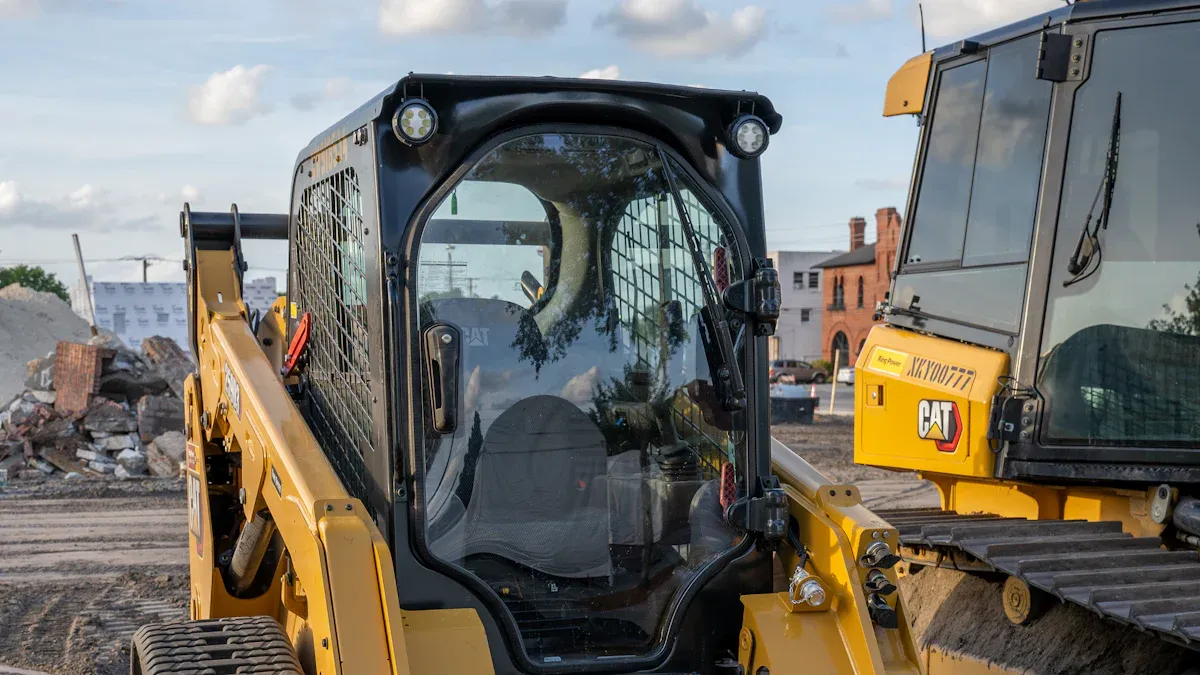
Rubber Tracks for Track Loader help workers finish jobs faster and with more confidence. Many teams see up to 25% more productivity when they choose the right tracks.
- Skid steers with special tread patterns complete landscaping 20% faster in cities.
- Rubber tracks lower soil compaction by 15%, making work smoother and more efficient.
Key Takeaways
- Rubber tracks improve traction and stability on many surfaces, helping operators work faster and safer in tough conditions like mud, snow, and slopes.
- Advanced rubber tracks reduce downtime with self-cleaning treads and strong materials that resist damage, letting teams finish projects without frequent repairs or replacements.
- Operators enjoy smoother, quieter rides with less vibration, which boosts comfort and focus, allowing longer, more productive work shifts.
Enhanced Traction and Stability with Rubber Tracks for Track Loader
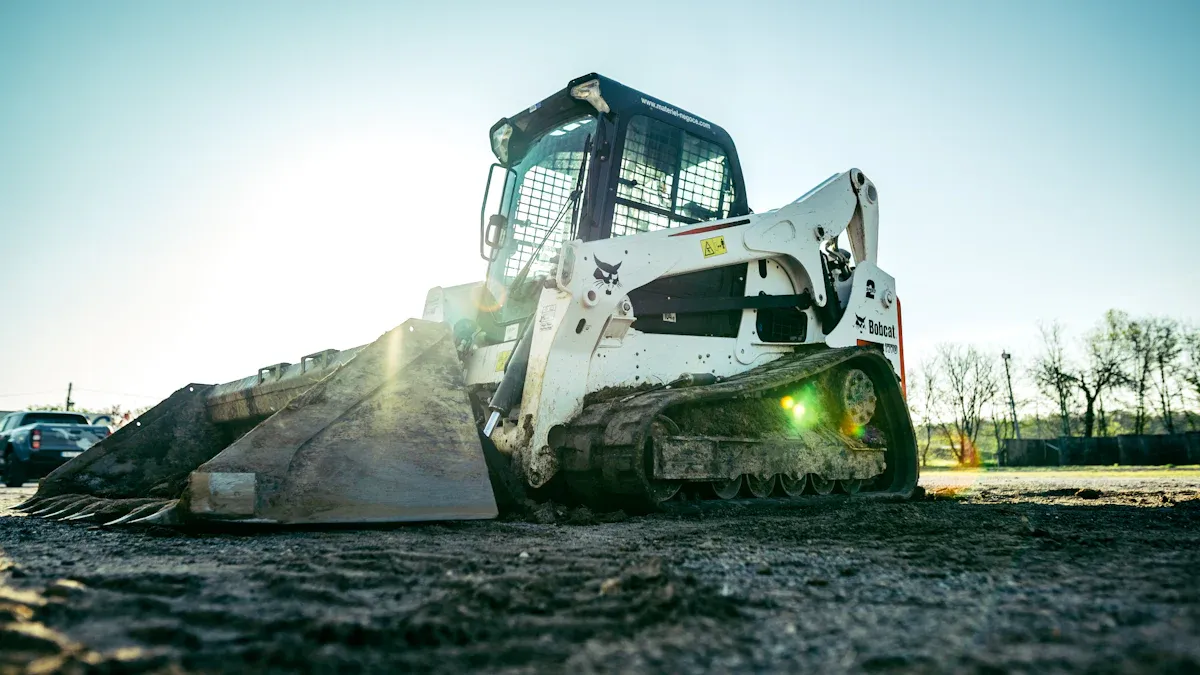
Improved Grip on Multiple Surfaces
Rubber Tracks for Track Loader help operators tackle a wide range of surfaces with confidence. These tracks use specially formulated rubber compounds and advanced tread patterns to deliver strong grip on mud, turf, and pavement. Operators notice the difference when moving from soft soil to blacktop. The tracks protect delicate surfaces while maintaining traction, making them ideal for landscaping and roadwork.
Note: Rubber tracks concentrate pressure under rollers and idlers, which helps them adapt to different terrains. Their cleat designs allow for smooth movement across mud, snow, and grass. Teams see less surface damage and more consistent performance, especially in urban environments.
A recent industry report highlights that rubber tracks are now standard on many compact loaders because they offer enhanced traction and minimal ground impact. This innovation helps crews finish jobs faster and keeps landscapes looking fresh.
Safer, Faster Operation in Challenging Conditions
Operators face tough conditions every day. Wet slopes, slippery ground, and uneven terrain can slow down progress. Rubber tracks provide stability and safety, even when the weather turns bad. Serrated tread patterns and flexible rubber compounds prevent sliding and sinking, giving workers peace of mind.
- Crews work confidently on muddy or soft ground.
- Machines stay steady on slopes and rough terrain.
- Fewer interruptions mean faster job completion.
Research shows that upgraded rubber tracks improve stability and traction, allowing loaders to operate in places that were once too risky. Workers feel safer, and projects move forward without delay.
Reduced Downtime Thanks to Advanced Rubber Tracks for Track LoaderSelf-Cleaning Tread Patterns Minimize Interruptions
Teams often face delays when mud or debris builds up on their loader tracks. Advanced self-cleaning tread patterns solve this problem. Multi-bar and zig zag designs push out dirt and stones as the machine moves. This keeps the tracks clear and ready for action. Operators spend less time stopping to clean tracks and more time getting the job done.
- Parallel bars with spaces let mud escape easily.
- Tiered bars prevent slippage and keep traction strong.
- Less buildup means fewer interruptions and smoother progress.
Operators in construction and landscaping report that these self-cleaning features help them finish projects faster, even in wet or muddy conditions.
Puncture and Damage Resistance for Continuous Operation
Rubber Tracks for Track Loader use tough, multi-layer rubber compounds. These layers resist cuts and tears from sharp rocks or stumps. Reinforced sidewalls add extra strength. Machines keep moving, even on rough ground.
Field data shows a dramatic drop in work stoppages after switching to these tracks. Operators see up to 83% fewer tire-related delays. The optimized tread structure also reduces vibration and bending, which helps the tracks last longer and keeps the ride smooth.
| Metric | Traditional System | Advanced Rubber Tracks |
|---|---|---|
| Average Track Life | 500 hours | 1,200 hours |
| Annual Replacement Frequency | 2-3 times | Once yearly |
| Emergency Repair Calls | Baseline | 85% decrease |
| Total Track-Related Expenses | Baseline | 32% reduction |
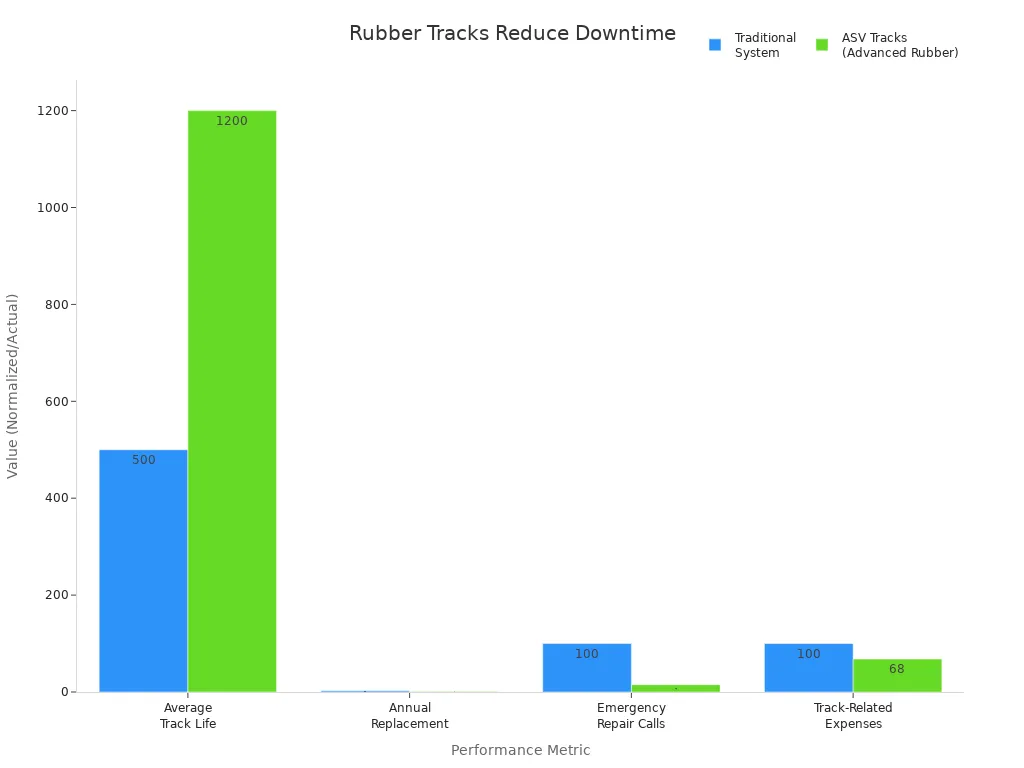
These improvements inspire teams to take on bigger challenges, knowing their equipment will keep up with their ambition.
Smoother Ride and Operator Comfort with Rubber Tracks for Track LoaderLess Vibration and Noise for Better Productivity
Operators feel the difference when they use Rubber Tracks for Excavator. These tracks create a quieter work environment and reduce vibration. Laboratory tests show that rubber track components lower vertical acceleration by over 60%. Noise levels drop by up to 18.6 dB compared to steel tracks. Operators report less fatigue and enjoy smoother rides.
A quieter cab helps workers stay focused. Less vibration means fewer aches and pains at the end of the day. Teams working in cities or residential areas appreciate the peaceful operation. The use of advanced tread patterns and continuous steel cord technology adds strength and further reduces vibration.
A simple table shows the benefits:
| Feature | Steel Tracks | Rubber Tracks |
|---|---|---|
| Vibration Reduction | Low | High |
| Noise Level | High | Low |
| Operator Fatigue | High | Low |
Longer, More Comfortable Shifts
Comfort matters for every operator. Rubber tracks with special tread patterns and noise-absorbing materials make long shifts easier. User surveys reveal that operators can work longer hours without feeling tired. Suspension seats, padded armrests, and ergonomic cab designs work together with rubber tracks to create a pleasant workspace.
Operators stay alert and productive throughout the day. They experience less stress and more satisfaction with their work. Teams finish jobs faster because they feel good and stay focused.
Many experts believe that comfort leads to better performance. When operators feel comfortable, they deliver their best work and help projects succeed.
Versatility Across Surfaces Using Rubber Tracks for Track Loader
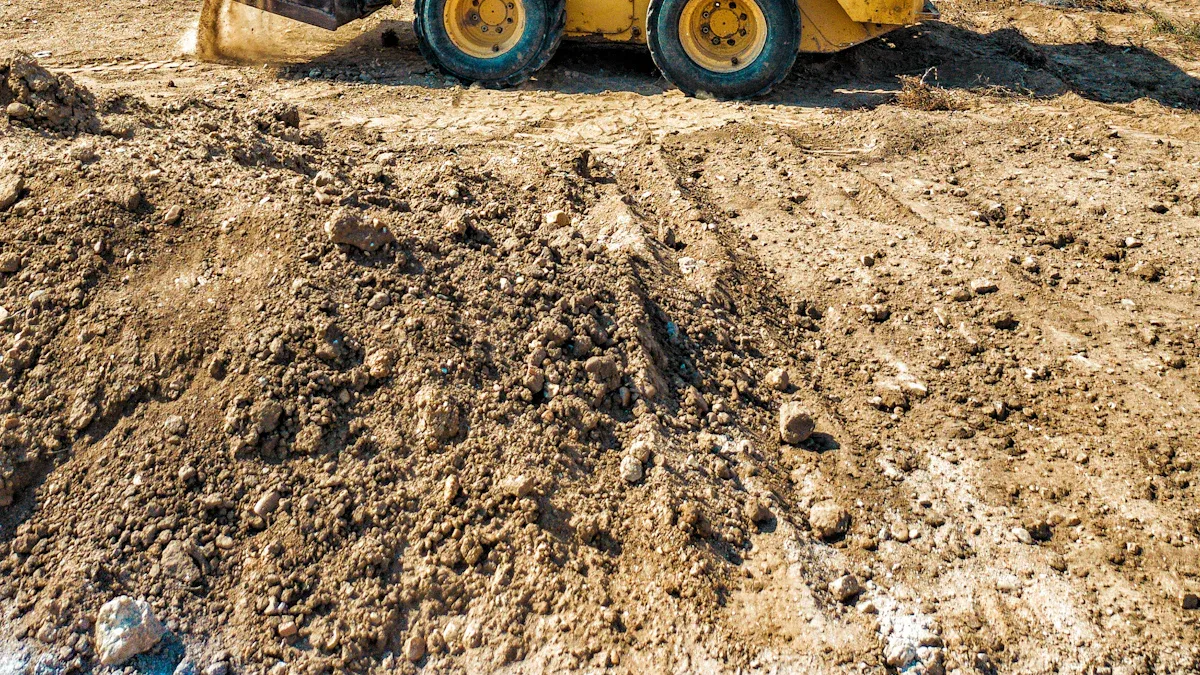
Adaptability to Different Terrains Speeds Up Job Completion
Track loaders show their true power when they move across different surfaces. Operators see machines glide over mud, sand, rocks, turf, and snow without slowing down. Specialized tread patterns help loaders grip each surface. Directional treads push through mud and snow, while lateral treads keep the loader steady on grass and slopes. Block and hybrid patterns balance grip and smooth movement on hard ground.
Operators feel confident as they switch from one job site to another. They notice less ground damage, even on delicate lawns or golf courses. Advanced rubber compounds and steel inserts make tracks strong and flexible. Machines work longer in tough weather and rough terrain. Teams finish jobs faster because they do not waste time fixing tracks or getting stuck.
- Tracks perform well on mud, sand, rocks, turf, and snow.
- Tread patterns match the needs of each surface.
- Machines move smoothly in tight spaces and uneven ground.
- Operators report less downtime and easier maneuvering.
Tip: Wider tracks spread the loader’s weight, lowering ground pressure and preventing sinking. This helps teams work quickly on soft ground.
No Need for Frequent Track Changes
Operators save time and effort with durable rubber tracks. Premium tracks last between 1,000 and 1,500 hours, while well-maintained tracks can reach up to 2,000 hours. Daily checks and cleaning extend track life. Teams spend less time replacing tracks and more time working.
Rubber tracks need fewer changes than steel tracks. Their strong materials resist cuts, tears, and wear. Operators enjoy longer intervals between replacements. This reduces labor costs and keeps projects moving forward.
Note: Less frequent track changes mean more time on the job and less time in the shop. Teams stay productive and finish tasks ahead of schedule.
Lower Ground Pressure with Rubber Tracks for Track LoaderFaster Movement on Soft or Sensitive Ground
Track loaders often face challenges on soft or sensitive ground. When machines sink or slip, progress slows and frustration grows. Rubber tracks change the game by spreading the loader’s weight over a larger area. This wide footprint lowers ground pressure, so the machine glides across mud, sand, or turf without leaving deep marks. Operators notice how the loader moves faster and with more control, even in tricky spots.
Field tests show that this design reduces ground pressure by up to 75%. The loader gains more traction and stability, which means less time spent getting unstuck and more time moving forward. Teams see real results in their daily work. They finish jobs on golf courses, parks, and construction sites with less damage to the ground and more pride in their work.
| Performance Metric | Improvement / Value | Benefit / Explanation |
|---|---|---|
| Ground pressure | Up to 75% less | Reduces soil compaction and prevents sinking |
| Tractive effort (low gear) | +13.5% | Increases pushing power and traction |
| Resistance to sideways slip | Up to 60% | Enhances control and reduces slipping |
| Turning precision | Improved | Allows better maneuverability on soft ground |
Reduced Risk of Getting Stuck
Operators want to keep moving, not waste time digging out stuck machines. Excavator tracks help loaders stay on top of soft ground. The straight bar tread pattern grips wet and muddy surfaces, making it easier to steer and turn. Teams can choose from different tread designs to match the job site, giving them the confidence to tackle any terrain.
- Rubber tracks perform well in wet and muddy conditions.
- The straight bar tread pattern provides excellent maneuverability.
- Machines are less likely to get stuck compared to steel tracks.
- Multiple tread options allow customization for each surface.
- Even weight distribution lowers the risk of sinking.
Every project becomes a chance to succeed. Operators feel empowered to take on new challenges, knowing their equipment will keep them moving forward.
Maintenance and Longevity of Rubber Tracks for Track LoaderEasy Maintenance for Less Downtime
Operators find that rubber tracks make daily maintenance simple and quick. These tracks resist debris jams and clean up easily, so teams spend less time on repairs and more time working. Industry reports show that rubber tracks need less attention than steel tracks, which means fewer interruptions during busy days.
- Clean the undercarriage after each job to remove mud, gravel, and other debris.
- Check track tension every day and adjust as needed to prevent early wear.
- Inspect for cuts or damage that could expose the track core.
- Use wide, gentle turns instead of sharp spins to protect the tread.
- Train operators to handle machines with care and choose the right tread pattern for each surface.
Regular cleaning and quick inspections help prevent problems before they start. Teams who follow these steps see less downtime and keep their projects moving forward.
Durable Construction for Extended Service Life
Rubber tracks use advanced materials and smart designs to last longer, even in tough conditions. Multi-layered rubber compounds and strong internal cables give the tracks extra strength. Specialized tread patterns match different terrains, helping the tracks grip better and wear more slowly.
| Factor | Description |
|---|---|
| Average Lifespan | Tracks last between 400 to 2,000 hours, depending on use and care. |
| Operator Skill | Careful driving and smooth turns extend track life. |
| Maintenance | Daily cleaning and tension checks prevent early wear. |
| Track Design | Different widths and patterns suit specific jobs and boost durability. |
| Internal Structure | Strong cables and tight bonding stop overstretching and failure. |
Operators who care for their tracks see them last longer and perform better. With the right habits, teams can rely on their equipment for many successful projects.
Product Features of Rubber Tracks for Mini DiggersSpecially Formulated Rubber Compounds for Durability
Engineers design rubber compounds to withstand tough environments. They blend natural and synthetic rubbers to create tracks that last longer and resist damage. Natural rubber gives elasticity and strength, while synthetic rubbers like SBR add abrasion resistance and stability in extreme temperatures.
- Carbon black and silica make the outer layer tough and flexible.
- UV stabilizers and antiozonants protect against sunlight and ozone.
- Reinforcing agents absorb energy at tear points, stopping cracks from spreading.
These advancements help tracks stay strong through heavy use. Operators see fewer tears and less wear, even on rough terrain. The tracks remain flexible in cold and resist deformation in heat. Teams trust their equipment to perform every day.
All-Steel Chain Links and Drop-Forged Steel Parts
Steel parts inside the tracks provide unmatched strength. Drop-forged steel inserts support the loader’s weight and keep the track aligned. Heat-treated alloys resist bending and wear, lowering the risk of de-tracking.All-steel chain links fit the machine perfectly, ensuring smooth movement. A special adhesive coats the steel parts, creating a strong bond with the rubber. Interlocking guide lugs increase stiffness and reduce vibration. Rounded edges protect against damage from curbs or rocks.These features help the tracks last longer and work reliably in harsh conditions. Operators feel confident as they tackle demanding jobs.
Innovative Tread Patterns for Specific Applications
Tread patterns shape how a loader performs on different surfaces. Designers create patterns for traction, comfort, and protection.
| Tread Pattern | Performance Characteristics | Best Use Cases |
|---|---|---|
| Lightning Bolt | Low vibration, high traction, gentle on turf | Asphalt, lawns, mixed terrain |
| Terrapin | Excellent wet traction, turf-friendly, resists rock damage | Construction, landscaping, rocky soil |
| Block Pattern | Smooth ride, strong grip, even weight distribution | Asphalt, concrete, mud |
| C-lug Pattern | Extra grip on soft ground, self-cleaning | Mud, clay, snow, rocks |
| V Pattern | Deep lugs, less soil damage, directional traction | Agriculture, light tasks |
| Zig Zag Pattern | Superior traction on loose ground, high self-cleaning | Mud, snow removal |
Hybrid designs combine the best features for versatility. Operators choose the right tread for each job, boosting performance and finishing tasks faster.
Rubber Tracks for Track Loader help teams finish jobs faster. Operators see better traction, less downtime, and smoother rides.
- Quick maintenance keeps machines moving.
- Versatile tracks work on many surfaces.
- Contractors avoid costly delays.
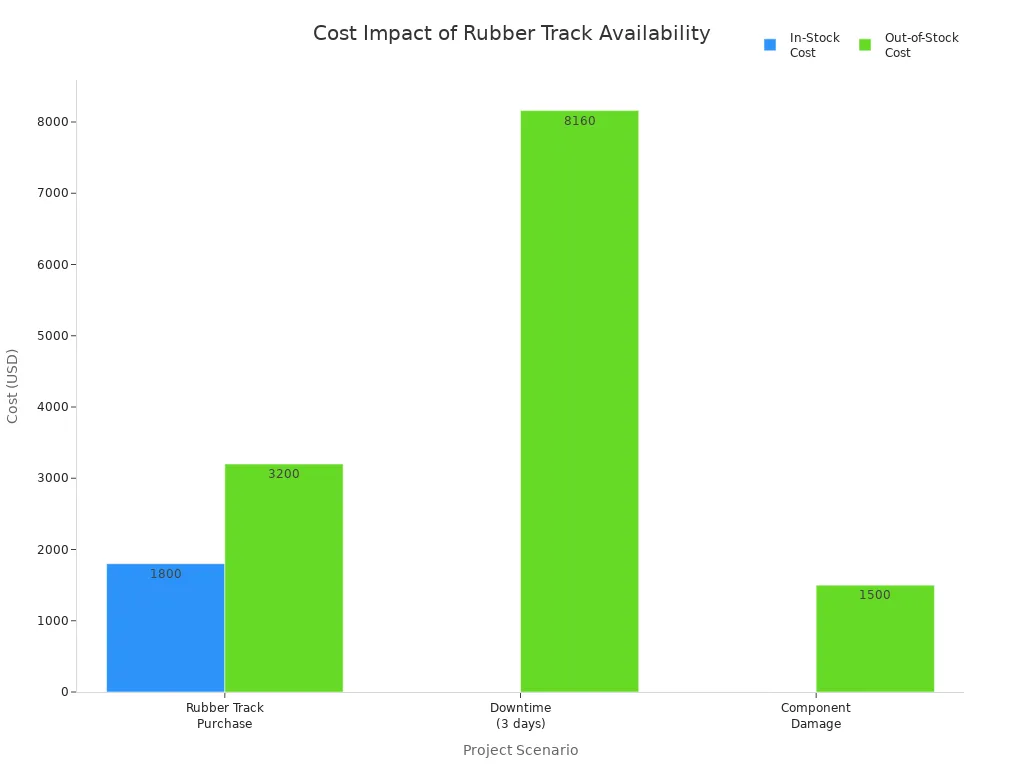
FAQ
How do rubber tracks help teams finish jobs faster?
Rubber tracks give machines better traction and stability. Teams move quickly across different surfaces. They spend less time stuck and more time getting work done.
Can operators use rubber tracks in all weather conditions?
Rubber tracks perform well in rain, snow, and mud. Operators stay productive in any season. They trust their equipment to handle tough environments.
What maintenance tips keep rubber tracks working longer?
- Clean tracks after each use.
- Check tension daily.
- Inspect for damage.
- Operators who care for their tracks enjoy longer service life and fewer delays.
Media Contact
Company Name: Gator Track Co., Ltd.
Email: Send Email
Country: China
Website: https://www.gatortrack.com/
